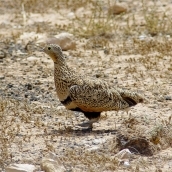Black-bellied Sandgrouse (Pterocles orientalis)
This steppe bird measures from 30-35 cm in total length, wingspan from 70-73 cm. Its plumage is cryptic and fully adapted to the environment in which it moves; sexual dimorphism is very pronounced. The male is more striking than the female and has an orange throat, a thin black band (like a collar) across its breast, with a golden-brown back. The female is light brown, with a speckled back, throat and breast, a collar across the breast and a black patch on the throat. Both sexes have a black belly. This species has rather short legs and a considerable capacity for flight. In Macaronesia the black-bellied sandgrouse is only found in the Canaries, more specifically Fuerteventura, but there have been sporadic sightings in Lanzarote and La Graciosa. In the past, it also appeared in Gran Canaria, where it was relatively common and may have bred. Sand dunes or areas of jable pumice and stony plains make up its chief habitat. It also frequents cultivated lands and the rocky hillsides of inland valleys; on occasion it can be seen in malpaíses or badlands. It mainly feeds on seeds and plant shoots, and drinks from ponds, dams, ravines with running water and small watering holes. This gregarious bird often gathers in sizeable flocks, particularly outside of the breeding season. Records of breeding in the Canaries are scarce, but clutches are known to consist of 2-3 eggs, laid in a hollow in the ground, and the breeding season extends from March to June, much later than the other steppe birds that share the same habitat, such as the houbara bustard (Chlamydotis undulata) and the stone curlew (Burhinus oedicnemus). Despite being relegated to just one island, this species occupies extensive areas, though distribution is not uniform. The highest numbers are found in the central and southern parts of Fuerteventura (La Pared or Jandía), and the population is estimated at around 1,000 to 3,500 specimens in steppe-like environments, although it could be higher. This species has been classified as Vulnerable on a national scale. Main threats in the Canaries include destruction and modification of steppe-like habitats, human encroachment, predation, poaching (sporadic) and collisions with overhead cables. The drought situation of the past few years is yet another factor, as it has led to the disappearance of several watering areas traditionally frequented by the black-bellied sandgrouse.













